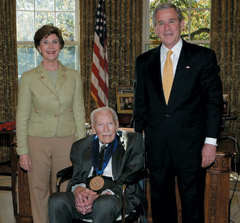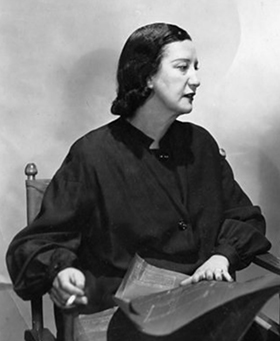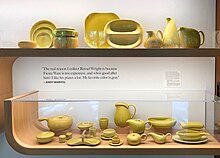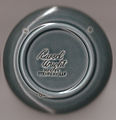
Fiesta is a line of ceramic glazed dinnerware manufactured and marketed by the Fiesta Tableware Company of Newell, West Virginia since its introduction in 1936, with a hiatus from 1973 to 1985. Fiesta is noted for its Art Deco styling and its range of often bold, solid colors.

Mid-century modern (MCM) is a design movement in interior, product, graphic design, architecture, and urban development that was popular in the United States and Europe from roughly 1945 to 1969, during the United States's post–World War II period. The term was used descriptively as early as the mid-1950s and was defined as a design movement by Cara Greenberg in her 1984 book Mid-Century Modern: Furniture of the 1950s. It is now recognized by scholars and museums worldwide as a significant design movement. The MCM design aesthetic is modern in style and construction, aligned with the Modernist movement of the period. It is typically characterized by clean, simple lines and honest use of materials, and it generally does not include decorative embellishments.

Viktor Schreckengost was an American industrial designer as well as a teacher, sculptor, and artist. His wide-ranging work included noted pottery designs, industrial design, bicycle design and seminal research on radar feedback. Schreckengost's peers included designers Raymond Loewy, Norman Bel Geddes, Eva Zeisel, and Russel Wright.

Russel Wright was an American industrial designer. His best-selling ceramic dinnerware was credited with encouraging the general public to enjoy creative modern design at table with his many other ranges of furniture, accessories, and textiles. The Russel and Mary Wright Design Gallery at Manitoga in upstate New York records how the "Wrights shaped modern American lifestyle".

The American Terracotta Tile and Ceramic Company was founded in 1881; originally as Spring Valley Tile Works; in Terra Cotta, Illinois, between Crystal Lake, Illinois and McHenry, Illinois near Chicago by William Day Gates. It became the country's first manufactury of architectural terracotta in 1889. The production consisted of drain tile, brick, chimney tops, finials, urns, and other economically fireproof building materials. Gates used the facilities to experiment with clays and glazes in an effort to design a line of art pottery which led to the introduction of Teco Pottery. American Terra Cotta's records are housed at the University of Minnesota and include original architectural drawings.

Modern furniture refers to furniture produced from the late 19th century through the present that is influenced by modernism. Post-World War II ideals of cutting excess, commodification, and practicality of materials in design heavily influenced the aesthetic of the furniture. It was a tremendous departure from all furniture design that had gone before it. There was an opposition to the decorative arts, which included Art Nouveau, Neoclassical, and Victorian styles. Dark or gilded carved wood and richly patterned fabrics gave way to the glittering simplicity and geometry of polished metal. The forms of furniture evolved from visually heavy to visually light. This shift from decorative to minimalist principles of design can be attributed to the introduction of new technology, changes in philosophy, and the influences of the principles of architecture. As Philip Johnson, the founder of the Department of Architecture and Design at the Museum of Modern Art articulates:
"Today industrial design is functionally motivated and follows the same principles as modern architecture: machine-like simplicity, smoothness of surface, avoidance of ornament ... It is perhaps the most fundamental contrast between the two periods of design that in 1900 the Decorative Arts possessed ..."
The Fiesta Tableware Company is a ceramics manufacturer located in Newell, West Virginia, United States. Established in 1871, it is widely known for its Art Deco glazed dinnerware line, Fiesta.

Manitoga was the estate and modernist home of industrial designer Russel Wright (1904–1976) and his wife Mary Small Einstein Wright. It is located along New York State Route 9D south of Garrison, New York, a short distance north of the Bear Mountain Bridge.

J.A. Bauer Pottery is an American pottery that was founded in Paducah, Kentucky in 1895 and operated for most of its life in Los Angeles, California. It closed in 1962.
Juergen Nogai is a German architecture, art and documentary photographer.

Franciscan Ceramics are ceramic tableware and tile products produced by Gladding, McBean & Co. in Los Angeles, California, US from 1934 to 1962, International Pipe and Ceramics (Interpace) from 1962 to 1979, and Wedgwood from 1979 to 1983. Wedgwood closed the Los Angeles plant, and moved the production of dinnerware to England in 1983. Waterford Glass Group plc purchased Wedgwood in 1986, becoming Waterford Wedgwood. KPS Capital Partners acquired all of the holdings of Waterford Wedgwood in 2009. The Franciscan brand became part of a group of companies known as WWRD, an acronym for "Wedgwood Waterford Royal Doulton." WWRD continues to produce the Franciscan patterns Desert Rose and Apple.

Vernon Kilns was an American ceramic company in Vernon, California, US. In July 1931, Faye G. Bennison purchased the former Poxon China pottery renaming the company Vernon Kilns. Poxon China was located at 2300 East 52nd Street. Vernon produced ceramic tableware, art ware, giftware, and figurines. The company closed its doors in 1958.

John Durrant Larkin was an American business magnate who pioneered the mail-order business model, developed the marketing strategy of offering premiums to customers, introduced revolutionary employment innovations, and commissioned Frank Lloyd Wright's first major public work, the Larkin Administration Building.

Brayton Laguna Pottery produced ceramics (pottery) in Laguna Beach, California from 1927 to 1968.
Marguerita Mergentime (1894–1941) was an American textile designer best known for printed fabrics, making her mark in the 1930s with table linens in bold colors and innovative patterns created to enliven American households. Mergentime also designed sheets, towels, and tableware. In New York City in the 1930s, Mergentime worked with some of the best-known designers of the day, including Donald Deskey, Russel Wright, and Frederick Kiesler. Her work was featured in The New Yorker, House & Garden, House Beautiful, and Vogue.

Stangl Pottery was a company in Flemington, New Jersey, that manufactured a line of dinnerware and other items. The company was originally founded as Samuel Hill Pottery in 1814, until 1860 when it became Fulper Pottery. The name changed to Stangl Pottery in 1955. The company ceased production and closed in 1978, but the dinnerware is still prized by collectors. Pieces can be identified by the Stangl name on the bottom. The original Flemington, New Jersey, location and showroom was bought in May 2011 to make space for a restaurant, a studio, and an art gallery.
Michael Lax (1929–1999) was an American industrial designer who created household products for companies such as Copco, Lightolier, Dansk, Salton, Metaal, Mikasa, Tupperware, and American Cyanamid. Several of his best-known products, including the Lytegem lamp and an enamel-coated teakettle, are represented in permanent museum collections.

The International Museum of Dinnerware Design (IMoDD) is a 501(c)(3) organization located in Ann Arbor, MI established in 2012 by the museum's founding director, Dr. Margaret Carney. IMoDD is a design museum that "collects, preserves, and celebrates masterpieces of the tabletop genre created by leading artists and designers worldwide. Through its collections, exhibitions, and educational programming," IMoDD's mission statement says, "it provides a window on the varied cultural and societal attitudes toward food and dining and commemorates the objects that exalt and venerate the dining experience." IMoDD has around 9,000 objects in its permanent collection, consisting of work by contemporary artists as well as the leading designers for industry, with an additional focus on fine art referencing dining.

Mary Small Einstein Wright was an American designer, sculptor, author and businesswoman who worked to "shape modern American lifestyle". Wright and her husband Russel Wright co-founded the design business, Wright Accessories Inc., where she served as vice-president, factory supervisor and oversaw publicity, marketing, and promotion. She was a founder of America Designs Inc., an organization that supported the works of American industrial designers. Wright co-authored the best-selling book Guide to Easier Living that proposed lifestyle choices were analogous to "engineering problems with scientific solutions".

Tamac Pottery was a line of mid-century modern ceramic glazed dinnerware that was manufactured in Perry Oklahoma from 1946 to 1972. The stream-lined biomorphic pottery line included tableware and housewares.




















